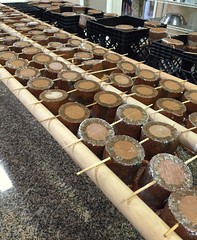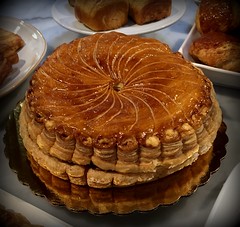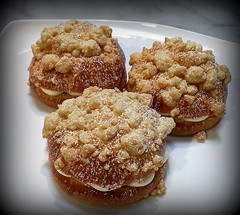Work has been intense and crazy. So I was thrilled when the executives decided at the last minute to build in a little break in the project timeline. As luck would have it, the break was the same week as the Viennoiserie 2 class at the San Francisco Baking Institute (SFBI). Viennoiserie 1 is offered a few times a year, but level 2 is offered only once a year. I wasn't able to take level 2 last year since it was fully enrolled when I tried to sign up, so I was happy to attend this year. A sane person would've gone to Bora Bora or Hawaii, but I chose to spend my vacation in a week long (40 hour) pastry class.
Here are some of pastries we made in class. These were just the tip of iceberg. We made a whole lotta Viennoiserie during the week. The lead photo (above) is gibassier which is an olive oil brioche with candied orange peel and anise seeds.
Hot Croissants

Panettone Cooling Upside Down

A Single Day's Take Home (Everyday was like this!)

Chocolate Panettone (Chocolate panettone dough made with Italian levain, mini chocolate chips, cocoa nib praline, topped with a chocolate glaze and sliced almonds.)

Colomba de Pasqua (Easter dove. Topped with a hazelnut glaze and chopped hazelnuts.)

Savory Kugelhopf (Bundt form and baking cups.Asiago cheese, parsley, thyme, raisins, walnuts.)

Pithivier (Inverted puff pastry, raspberry jam, frangipane.)

Traditional Croissants

Chocolate Croissants

Stollen

Brioche Tropezienne (Brioche, almond streusel, rum diplomat cream.)

Since the class was an advanced Viennoiserie class, almost everyone in the class was a professional baker. There were a few semi-professionals who sold their baked goods on the side while maintaining a full time day job, but they all hoped to open a bakery some day. I was the only non-professional in the class.When classmates asked if I planned to have a bakery or baking business some day, my answer was "No, I don't. I just bake for fun".
If they had asked me that question a year ago, my answer would have been "Yes, some day". It's a question that I have struggled with for many years. In the last year, I've done a lot of baking, as well as as lot of soul searching. Like many of the TFLers, I bake because I am passionate it about. I freely admit that it would be nice to turn my passion into a career, but I know that I will not be. My decision makes me happy. I don't have to wonder about "some day" anymore.
:) Mary